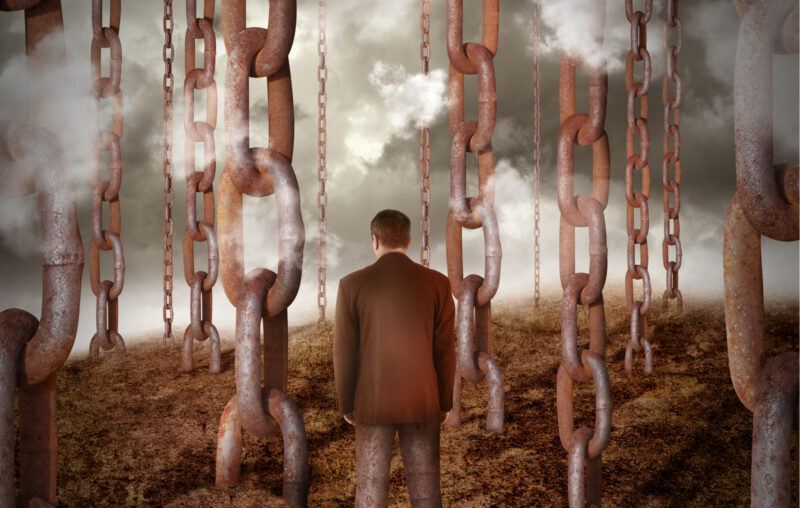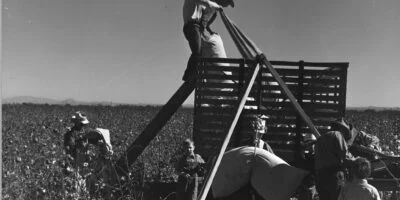Liberty or Subjugation?

The first half of the nineteenth century witnessed two titanic political struggles in the United States. One pitted Masons against Antimasons while the other arrayed the forces of Slavery against those of Antislavery. Both struggles ultimately posed the same question as the Revolution had. Would Americans enjoy liberty or suffer subjugation?
Today, Americans face the same question but it isn’t clear that liberty shall again prevail because Americans seem not to “esteem” their liberties as “jealously” as they once did. Many blame the recent retreat of economic freedom and civil liberties on ostensibly new technological or social forces. The following jaunt through America’s antebellum history, however, reveals that nothing new faces lovers of liberty except that the massive size and power of the state has weakened their ability to fend off subjugation, be it in the form of dangerous lockdowns or the blatant favoritism of some (e.g., elites) over others (e.g., regular Joes and Janes).
Antebellum Americans adored most voluntary associations, especially those that today we would label nonprofits. Charities (asylums for the blind, indigent, or mad; hospitals; orphanages, etc.), fraternal organizations (e.g., Odd Fellows; YMCA), and institutions of self-improvement (libraries; lyceums; temperance societies; universities) generally met with high praise and donations.
Voluntary associations that took on a political cast, by contrast, were often met with derision, even vitriol, and sometimes violence. “Secret” societies were naturally particularly suspect because outsiders could easily weave them into conspiracy theories about lost elections and hated policies. If such associations had nothing to hide, why did they hide their activities?
The Society of the Cincinnati, a hereditary society formed by Revolutionary War officers in 1783, was widely decried at first, as were the political organizations that sprang up in opposition to the policies of the Washington administration in the early 1790s. Both survive to this day, the first under its original name and the second, along a much more complicated path, as the Democratic Party. Both helped to cement the concept of “loyal opposition” into Americans’ political psyches. To disagree over policy — even stridently, vociferously, or raucously — did not entail treason or insurrection, even if an organization’s strategies, or “machinations” in the parlance of the day, necessitated a certain level of secrecy, so long as its end goal, gaining control of the government through lawful elections, remained paramount.
The Masons, though, were different. The organization presented itself to the public as a fraternal organization and charity and hence, like similar organizations that suffused antebellum America, worthy of praise. But many outsiders believed that was simply cover for a more insidious mission. Anti-Masonic angst was not so much about the society’s secret handshakes, initiation rites, and passwords as it was about the secret oaths that its members purportedly took that placed the interests of Masons above those of American society. That threat seemed very real in 1826 after several Masons allegedly murdered William Morgan for threatening to expose Masonic secrets and then used their positions in government to cover up the crime.
Anti-Masons also feared that Masons concentrated power in the hands of a few men at the top of the association, which was organized as local lodges that, like many large-scale nonprofits, fed money up to the organization’s national leaders. As Unitarian preacher William Ellery Channing (1780-1842, not to be confused with the poet of the same name) explained, “Through such an Association, widely spread, yet closely connected by party feeling, a few leaders can send their voices and spirit far and wide, and, where great funds accumulated, can league a host of instruments, and by menace and appeals to interest, can silence opposition” [Remarks on the Disposition Which Now Prevails to Form Associations, and to Accomplish All Objects by Organized Masses (London: Edward Rainford, 1830), 18-19].
What are Amazon, Facebook, Google, Twitter, and the like but widely spread associations closely connected by party feeling where great funds have accumulated and been used to silence opposition, from lone bloggers and videographers to corporations like Parler, by menace and appeals to interest? As if to make clear that readers today understand what is at stake, Channing continued: “We fear that in this country, an influence is growing up through widely spread Societies, altogether at war with the spirit of our institutions, and which, unless jealously watched, will gradually but surely encroach on freedom of thought, of speech, of the press.” That influence proved gradual indeed but was firmly as sure as Channing feared.
Channing also lamented that “a few individuals, perhaps not more than twenty, may determine the chief reading for a great part of children of the community, and for a majority of the adults, and may deluge our country with worthless sectarian writings, fitted only to pervert its taste, degrade its intellect, and madden it with intolerance.” Again, what do we have today but widespread fears that a few powerful associations, particularly those mentioned above, decide what most Americans read, be it about elections, lockdowns, politicians, racism, or viruses?
Although the dominant technology of (dis)information dissemination has changed since Channing’s day, the incentive mechanisms have not. Compare this exposé of the overlapping funding sources of a network of think tanks today with Channing’s warning then:
“Let Associations devoted to any objects which excite the passions, be everywhere spread and leagued together for mutual support, and nothing is easier than to establish a controul [sic] over newspapers. We are persuaded by an artful multiplication of Societies, devoted apparently to different objects, but all swayed by the same leaders, and all intended to bear against a hated party, as cruel a persecution may be carried on in a free country as in a despotism.”
Channing even described a type of cancel culture where “public opinion may be so combined, and inflamed, and brought to bear on odious individuals or opinions, that it will be as perilous to think and speak with manly freedom, as if an Inquisition were open before us. [Remember he was writing in the early nineteenth century, when some people still expected the Spanish Inquisition.] It is now discovered that the way to rule in this country is by an array of numbers, which a prudent man will not like to face,” especially without a mask!
While clearly prescient, Channing took too pessimistic a view given the reality of his time. America’s governments were then too small to effectively suppress the market for ideas. Rightly or not, Anti-Masons effectively deplatformed Masons in several states, including Massachusetts, where the corporate charters of Masonic lodges were repealed. Importantly, though, Masonic lodges continued to exist, even in Massachusetts, but in a chastened state that no longer seemed to threaten the rule of law. Its mission achieved, Anti-Masonry eventually petered out as a political force, with many former members joining the new Whig Party.
Like the Anti-Masons, who coalesced around opposition to the threat they perceived in Masonic lodges, abolitionists coalesced around opposition to the threat posed by chattel slavery. They did not style themselves Pro-Liberty because many of them did not seek racial equality, hoping that freed slaves could be transplanted to Africa, Latin America, or the Great West, perhaps on Reservations like those contemplated for American Indians. The abolitionists most in favor of liberty for all, those who sought immediate emancipation of slaves and equal rights for all regardless of skin color, were the most maligned.
Those so-called “radical” antislavery agitators were sometimes assaulted, even murdered, and rioters disrupted many of their meetings, sometimes by burning their meeting halls or threatening conferees, even female ones, with violence. And that was in the North! Meanwhile “the life of a known Abolitionist,” a British abolitionist noted in 1846, “would not be safe in a Southern State” [Anon., A Brief Notice of American Slavery, and the Abolition Movement (Bristol: H. C. Evans, 1846), 29].
Even the U.S. government sought to silence the radicals. The Post Office stopped delivering abolitionist tracts in the South after slaveholders resorted to violence, including lynchings, and social ostracism to stanch the flow of over 100,000 antislavery tracts into the slave states in 1835. Instead of countering new Southern state laws banning the possession of abolitionist literature, the brave U.S. House of Representatives responded by refusing to consider any more anti-slavery petitions.
Despite the still small government’s best efforts, however, antislavery agitation continued. Eventually it fomented a civil war that ironically allowed the first great ratcheting up of the U.S. government’s power. Two more big shooting wars and an endless stream of minor, cold, and metaphorical wars against this and that have since rendered the U.S. government so large that its sundry agencies now crowd out independent sources of information. Instead of a free flow of critique, data, information, and interpretation, the market for ideas is now dominated by what nineteenth century Americans would have called a “phalanx” of institutions led by the federal government and bolstered by sundry “yes” (wo)men fearful of invoking its mighty regulatory and confiscatory wrath.
One result has been a policy response so out of proportion to the threat posed by Covid that it beggars belief. Or so concludes a trio of researchers (two Spanish and one Chilean) in an article called “COVID-19 and The Political Economy of Mass Hysteria” published recently in an open access Swiss public health journal. Specifically, the researchers show, governments exacerbated nocebo effects (the opposite of placebo effects), aiding the spread of Covid by creating mass expectations of mass illness.
With free market checks against disinformation — which can be as simple as private conversations about recent events — largely disabled by overly powerful governments, a nocebo snowball effect occurred. People concluded that for governments to lock down economies and suspend civil liberties Covid must constitute a plague of Biblical proportions. So instead of resisting, they supported lockdowns, mandatory masking, and the silly social distancing theater showcased in the recent broadcast of Super Bowl LV.
In short, regardless of the origins of the SARS-COV-2 virus, Big Government caused the pandemic and the resulting economic pain by rendering resistance futile and breaking the will of all but a few outlets (like this one). The sooner Americans come to terms with that reality, the sooner they can take steps to render lockdowns, and God knows what other harmful, irrational policies lurking in the shadows, less likely, if not impossible.









